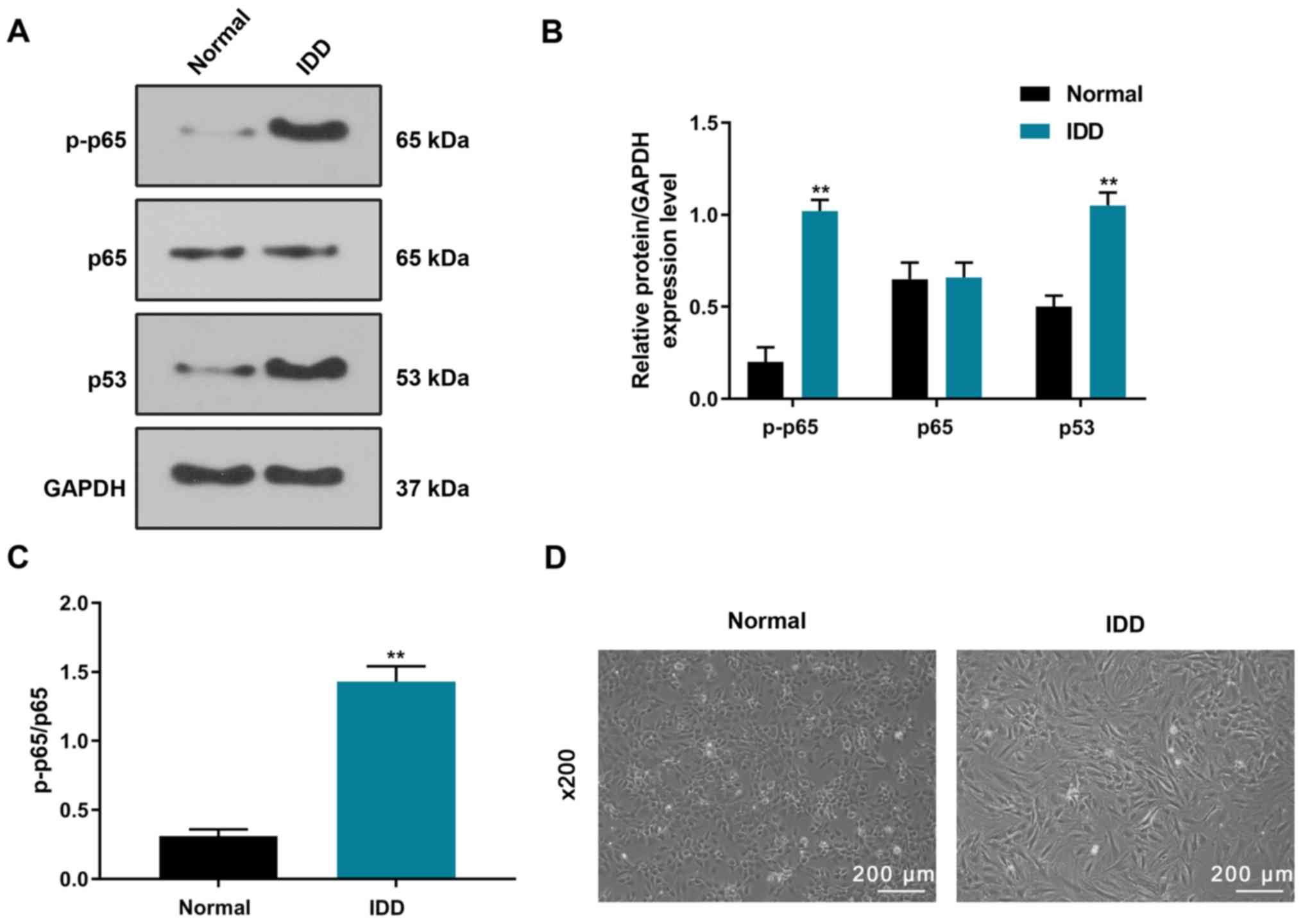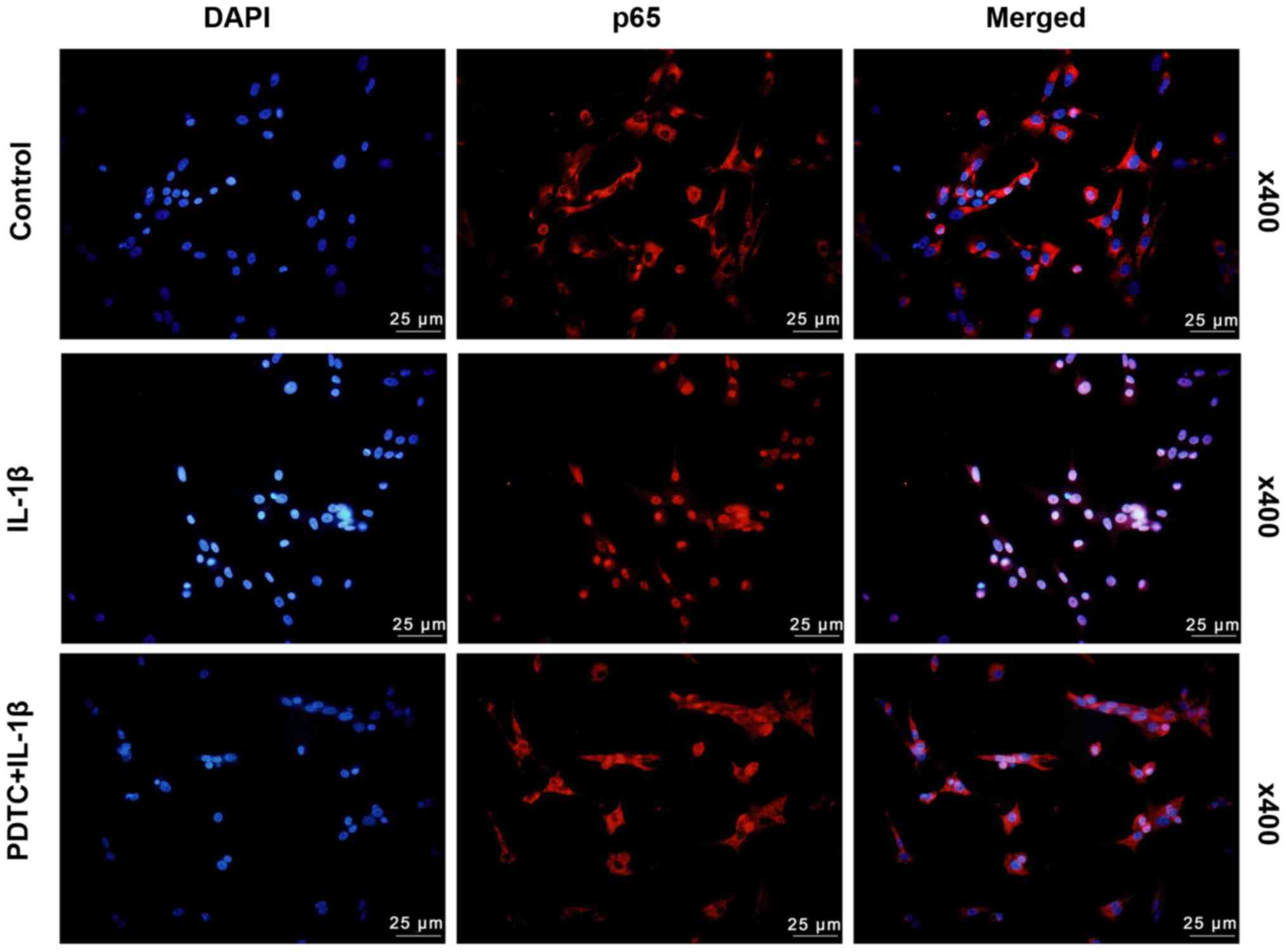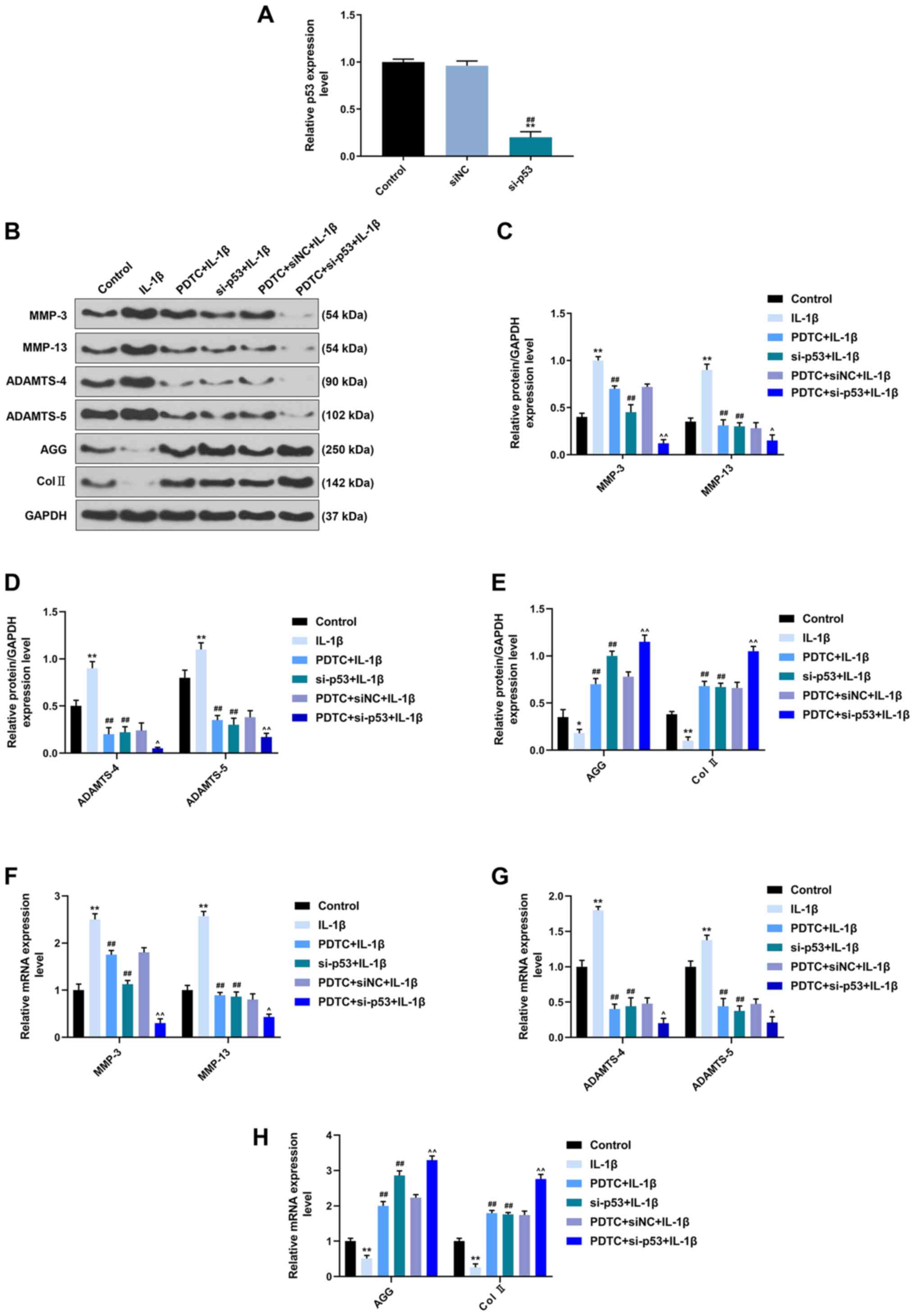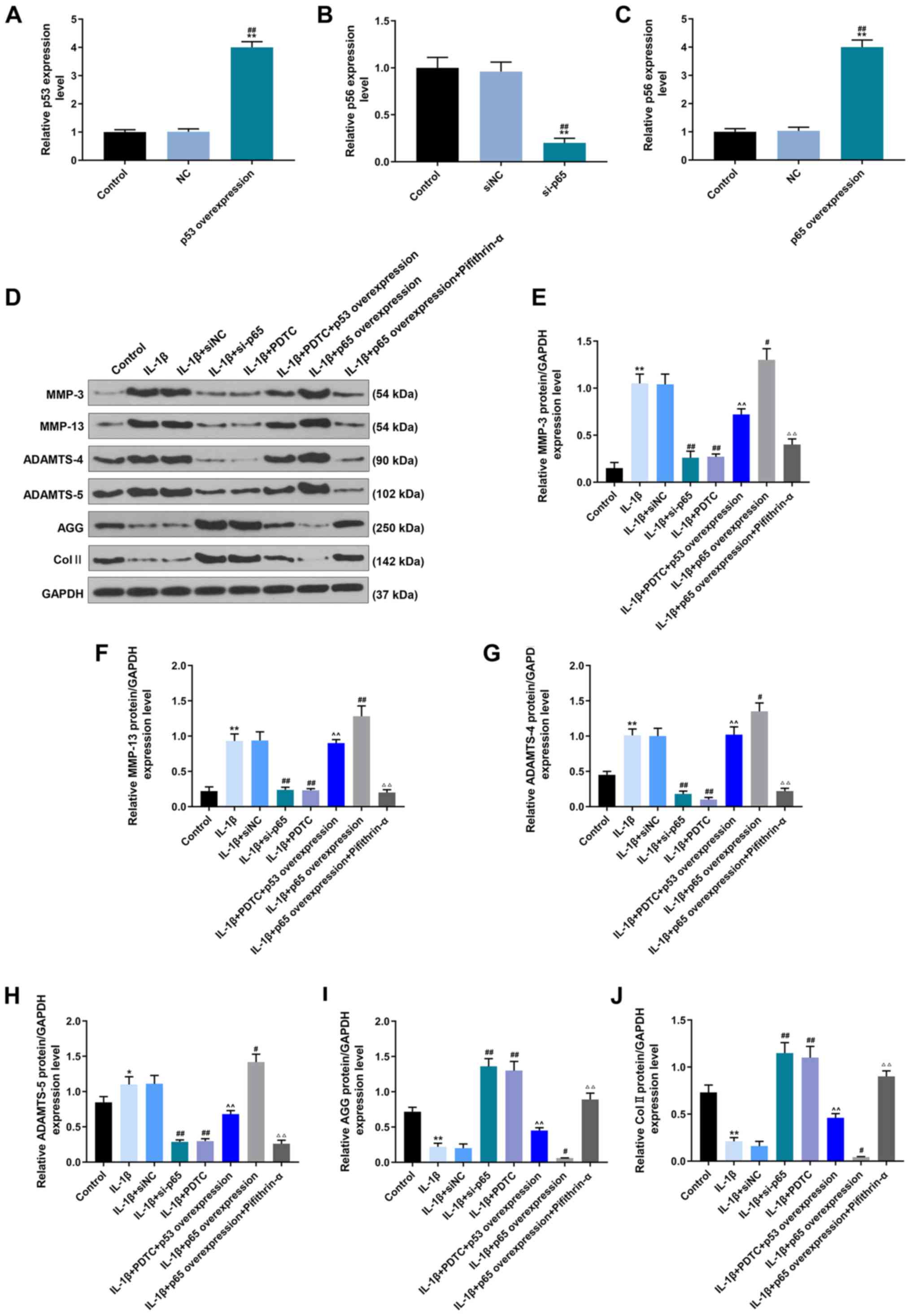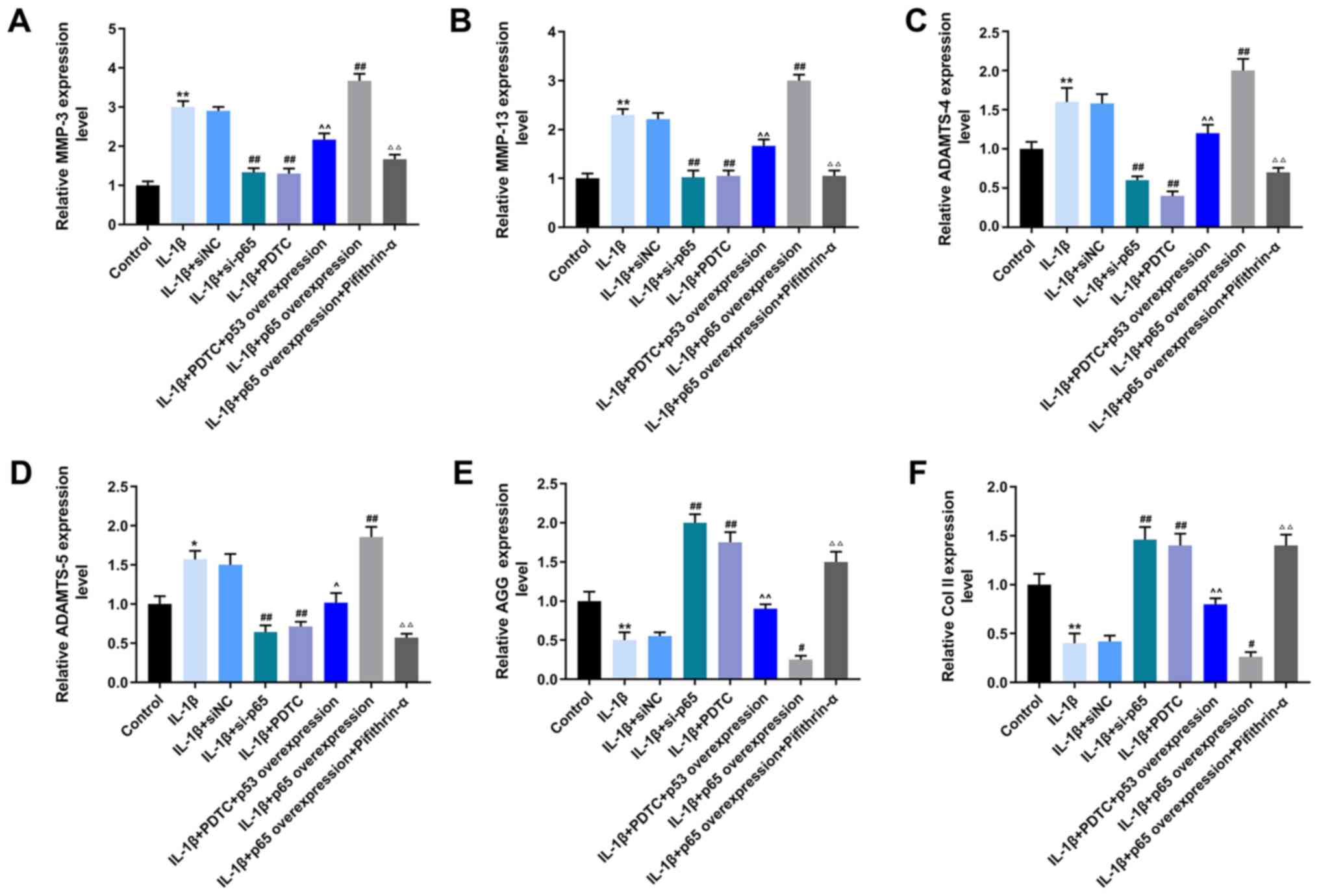|
1
|
Hoy D, Brooks P, Blyth F and Buchbinder R:
The epidemiology of low back pain. Best Pract Res Clin Rheumatol.
24:769–781. 2010. View Article : Google Scholar : PubMed/NCBI
|
|
2
|
Gungor C, Tang R, Sesek R, Davis G and
Gallagher S: Regression models for the erector spinae muscle (ESM)
cross-sectional area (CSA): Asymptomatic populations. J Biomech
Eng. 24:11152019.
|
|
3
|
Chou PH, Wang ST, Yen MH, Liu CL, Chang MC
and Lee OK: Fluid-induced, shear stress-regulated extracellular
matrix and matrix metalloproteinase genes expression on human
annulus fibrosus cells. Stem Cell Rese Ther. 7:342016. View Article : Google Scholar
|
|
4
|
Ye F, Wang H, Zheng Z, He P, Sribastav SS,
Wang H, Wang J, Liu H and Leung VYL: Role of SHOX2 in the
development of intervertebral disc degeneration. J Orthop Res.
35:1047–1057. 2017. View Article : Google Scholar : PubMed/NCBI
|
|
5
|
Le Maitre CL, Freemont AJ and Hoyland JA:
Localization of degradative enzymes and their inhibitors in the
degenerate human intervertebral disc. J Pathol. 204:47–54. 2004.
View Article : Google Scholar : PubMed/NCBI
|
|
6
|
Tsukifuji R, Tagawa K, Hatamochi A and
Shinkai H: Expression of matrix metalloproteinase-1, −2 and −3 in
squamous cell carcinoma and actinic keratosis. Br J Cancer.
80:1087–1091. 1999. View Article : Google Scholar : PubMed/NCBI
|
|
7
|
Hangai M, Kaneoka K, Kuno S, Hinotsu S,
Sakane M, Mamizuka N, Sakai S and Ochiai N: Factors associated with
lumbar intervertebral disc degeneration in the elderly. Spine J.
8:732–740. 2008. View Article : Google Scholar : PubMed/NCBI
|
|
8
|
Vo NV, Hartman RA, Yurube T, Jacobs LJ,
Sowa GA and Kang JD: Expression and regulation of
metalloproteinases and their inhibitors in intervertebral disc
aging and degeneration. Spine J. 13:331–341. 2013. View Article : Google Scholar : PubMed/NCBI
|
|
9
|
Xu F, Gao F, Liu Y, Wang Z, Zhuang X, Qu
Z, Ma H, Liu Y, Fu C, Zhang Q and Duan X: Bioinformatics analysis
of molecular mechanisms involved in intervertebral disc
degeneration induced by TNF-α and IL-1β. Mol Med Rep. 13:2925–2931.
2016. View Article : Google Scholar : PubMed/NCBI
|
|
10
|
Wang SL, Yu YL, Tang CL and Lv FZ: Effects
of TGF-β1 and IL-1β on expression of ADAMTS enzymes and TIMP-3 in
human intervertebral disc degeneration. Exp Ther Med. 6:1522–1526.
2013. View Article : Google Scholar : PubMed/NCBI
|
|
11
|
Hanaei S, Abdollahzade S, Sadr M,
Mirbolouk MH, Khoshnevisan A and Rezaei N: Association of IL10 and
TGFB single nucleotide polymorphisms with intervertebral disc
degeneration in Iranian population: A case control study. BMC Med
Genet. 19:592018. View Article : Google Scholar : PubMed/NCBI
|
|
12
|
Antoniou J, Steffen T, Nelson F,
Winterbottom N, Hollander AP, Poole RA, Aebi M and Alini M: The
human lumbar intervertebral disc: Evidence for changes in the
biosynthesis and denaturation of the extracellular matrix with
growth, maturation, ageing, and degeneration. J Clin Invest.
98:996–1003. 1996. View Article : Google Scholar : PubMed/NCBI
|
|
13
|
Fenini G, Contassot E and French LE:
Potential of IL-1, IL-18 and inflammasome inhibition for the
treatment of inflammatory skin diseases. Front Pharmacol.
8:2782017. View Article : Google Scholar : PubMed/NCBI
|
|
14
|
Fang L, Cheng Q, Zhao F, Cheng H, Luo Y,
Bao X, Li Y, Liang X, Huang Y, Xu J, et al: Cigarette smoke
exposure combined with lipopolysaccharides induced pulmonary
fibrosis in mice. Respir Physiol Neurobiol. 266:9–17. 2019.
View Article : Google Scholar : PubMed/NCBI
|
|
15
|
Hoyland JA, Le Maitre C and Freemont AJ:
Investigation of the role of IL-1 and TNF in matrix degradation in
the intervertebral disc. Rheumatology (Oxford). 47:809–814. 2008.
View Article : Google Scholar : PubMed/NCBI
|
|
16
|
Jin W, Xu X, Chen X, Qi W, Lu J, Yan X,
Zhao D, Cong D, Li X and Sun L: Protective effect of pig brain
polypeptides against corticosterone-induced oxidative stress,
inflammatory response, and apoptosis in PC12 cells. Biomed
Pharmacother. 115:1088902019. View Article : Google Scholar : PubMed/NCBI
|
|
17
|
Sabir JSM, El Omri A, Shaik NA,
Banaganapalli B, Al-Shaeri MA, Alkenani NA, Hajrah NH, Awan ZA,
Zrelli H, Elango R and Khan M: Identification of key regulatory
genes connected to NF-κB family of proteins in visceral adipose
tissues using gene expression and weighted protein interaction
network. PLoS One. 14:e02143372019. View Article : Google Scholar : PubMed/NCBI
|
|
18
|
Zhang Q, Mao Z and Sun J: NF-κB inhibitor,
BAY11-7082, suppresses M2 tumor-associated macrophage induced EMT
potential via miR-30a/NF-κB/Snail signaling in bladder cancer
cells. Gene. 710:91–97. 2019. View Article : Google Scholar : PubMed/NCBI
|
|
19
|
Wang RK, Shao XM, Yang JP, Yan HL and Shao
Y: MicroRNA-145 inhibits proliferation and promotes apoptosis of
hepG2 cells by targeting ROCK1 through the ROCK1/NF-κB signaling
pathway. Eur Rev Med Pharmacol Sci. 23:2777–2785. 2019.PubMed/NCBI
|
|
20
|
Wang K, Chen T, Ying X, Zhang Z, Shao Z,
Lin J, Xu T, Chen Y, Wang X, Chen J and Sheng S: Ligustilide
alleviated IL-1β induced apoptosis and extracellular matrix
degradation of nucleus pulposus cells and attenuates intervertebral
disc degeneration in vivo. Int Immunopharmacol. 69:398–407. 2019.
View Article : Google Scholar : PubMed/NCBI
|
|
21
|
Feng C, Zhang Y, Yang M, Lan M, Liu H,
Huang B and Zhou Y: Oxygen-Sensing Nox4 generates genotoxic ROS to
induce premature senescence of nucleus pulposus cells through MAPK
and NF-κB pathways. Oxid Med Cell Longev. 2017:74264582017.
View Article : Google Scholar : PubMed/NCBI
|
|
22
|
Jin LZ, Lu JS and Gao JW: Silencing SUMO2
promotes protection against degradation and apoptosis of nucleus
pulposus cells through p53 signaling pathway in intervertebral disc
degeneration. Biosci Rep. 38:BSR20171232018. View Article : Google Scholar
|
|
23
|
Ruan Z, Ma H, Li J, Liu H, Jia H and Li F:
The long non-coding RNA NEAT1 contributes to extracellular matrix
degradation in degenerative human nucleus pulposus cells. Exp Biol
Med (Maywood). 243:595–600. 2018. View Article : Google Scholar : PubMed/NCBI
|
|
24
|
Pfirrmann CW, Metzdorf A, Zanetti M,
Hodler J and Boos N: Magnetic resonance classification of lumbar
intervertebral disc degeneration. Spine (Phila Pa 1976).
26:1873–1878. 2001. View Article : Google Scholar : PubMed/NCBI
|
|
25
|
Livak KJ and Schmittgen TD: Analysis of
relative gene expression data using real-time quantitative PCR and
the 2(-Delta Delta C(T)) method. Methods. 25:402–408. 2001.
View Article : Google Scholar : PubMed/NCBI
|
|
26
|
Yang M, Peng Y, Liu W, Zhou M, Meng Q and
Yuan C: Sirtuin 2 expression suppresses oxidative stress and
senescence of nucleus pulposus cells through inhibition of the
p53/p21 pathway. Biochem Biophys Res Commun. 513:616–622. 2019.
View Article : Google Scholar : PubMed/NCBI
|
|
27
|
Liu Y, Qu Y, Liu L, Zhao H, Ma H, Si M,
Cheng L and Nie L: PPAR-γ agonist pioglitazone protects against
IL-17 induced intervertebral disc inflammation and degeneration via
suppression of NF-κB signaling pathway. Int Immunopharmacol.
72:138–147. 2019. View Article : Google Scholar : PubMed/NCBI
|
|
28
|
Yamaguchi Y, Ayaki T, Li F, Tsujimura A,
Kamada M, Ito H, Maki T, Sawamoto N, Urushitani M and Takahashi R:
Phosphorylated NF-κB subunit p65 aggregates in granulovacuolar
degeneration and neurites in neurodegenerative diseases with
tauopathy. Neurosci Lett. 704:229–235. 2019. View Article : Google Scholar : PubMed/NCBI
|
|
29
|
Shen L, Xiao Y, Wu Q, Liu L, Zhang C and
Pan X: TLR4/NF-κB axis signaling pathway-dependent up-regulation of
miR-625-5p contributes to human intervertebral disc degeneration by
targeting COL1A1. Am J Transl Res. 11:1374–1388. 2019.PubMed/NCBI
|
|
30
|
Ma T, Guo CJ, Zhao X, Wu L, Sun SX and Jin
QH: The effect of curcumin on NF-κB expression in rat with lumbar
intervertebral disc degeneration. Eur Rev Med Pharmacol Sci.
19:1305–1314. 2015.PubMed/NCBI
|
|
31
|
Wang S, Liu C, Sun Z, Yan P, Liang H,
Huang K, Li C and Tian J: IL-1β increases asporin expression via
the NF-κB p65 pathway in nucleus pulposus cells during
intervertebral disc degeneration. Sci Rep. 7:41122017. View Article : Google Scholar : PubMed/NCBI
|
|
32
|
Lu L, Hu J, Wu Q, An Y, Cui W, Wang J and
Ye Z: Berberine prevents human nucleus pulposus cells from
IL-1β-induced extracellular matrix degradation and apoptosis by
inhibiting the NF-κB pathway. Int J Mol Med. 43:1679–1686.
2019.PubMed/NCBI
|
|
33
|
Chen L, Xie ZY, Liu L, Zhu L, Wang F, Fan
P, Sinkemani A, Zhang C, Hong X and Wu XT: Nuclear factor-kappa
B-dependent X-box binding protein 1 signalling promotes the
proliferation of nucleus pulposus cells under tumour necrosis
factor alpha stimulation. Cell Prolif. 52:e125422019. View Article : Google Scholar : PubMed/NCBI
|
|
34
|
Bai M, Yin HP, Zhao J, Li Y and Wu YM:
Roles of TREM2 in degeneration of human nucleus pulposus cells via
NF-κB p65. J Cell Biochem. 119:8784–8796. 2018. View Article : Google Scholar : PubMed/NCBI
|
|
35
|
Liu B, Lu R, Li H, Zhou Y, Zhang P, Bai L,
Chen D, Chen J, Li J, Yu P, et al: Zhen-Wu-Tang ameliorates
membranous nephropathy rats through inhibiting NF-κB pathway and
NLRP3 inflammasome. Phytomedicine. 59:1529132019. View Article : Google Scholar : PubMed/NCBI
|
|
36
|
Wang X, Simpson ER and Brown KA: P53:
Protection against tumor growth beyond effects on cell cycle and
apoptosis. Cancer Res. 75:5001–5007. 2015. View Article : Google Scholar : PubMed/NCBI
|
|
37
|
Engeland K: Cell cycle arrest through
indirect transcriptional repression by p53: I have a DREAM. Cell
Death Differ. 25:114–132. 2018. View Article : Google Scholar : PubMed/NCBI
|
|
38
|
Li Y, Cao L, Li J, Sun Z, Liu C, Liang H,
Wang D and Tian J: Influence of microgravity-induced intervertebral
disc degeneration of rats on expression levels of p53/p16 and
proinflammatory factors. Exp Ther Med. 17:1367–1373.
2019.PubMed/NCBI
|
|
39
|
Parlar A, Arslan SO, Doğan MF, Çam SA,
Yalçin A, Elibol E, Özer MK, Üçkardeş F and Kara H: The exogenous
administration of CB2 specific agonist, GW405833, inhibits
inflammation by reducing cytokine production and oxidative stress.
Exp Ther Med. 16:4900–4908. 2018.PubMed/NCBI
|
|
40
|
Weber A, Wasiliew P and Kracht M:
Interleukin-1 (IL-1) pathway. Sci Signal. 3(105)2010. View Article : Google Scholar
|
|
41
|
Liu Y, Li X and Jin A: Rapamycin inhibits
Nf-ΚB activation by autophagy to reduce catabolism in human
chondrocytes. J Invest Surg. 4:1–13. 2019. View Article : Google Scholar
|
|
42
|
Liu H, Xiong J, He T, Xiao T, Li Y, Yu Y,
Huang Y, Xu X, Huang Y, Zhang J, et al: High uric acid-induced
epithelial-mesenchymal transition of renal tubular epithelial cells
via the TLR4/NF-kB signaling pathway. Am J Nephrol. 46:333–342.
2017. View Article : Google Scholar : PubMed/NCBI
|
|
43
|
Wang WJ, Yu XH, Wang C, Yang W, He WS,
Zhang SJ, Yan YG and Zhang J: MMPs and ADAMTSs in intervertebral
disc degeneration. Clin Chim Acta. 448:238–246. 2015. View Article : Google Scholar : PubMed/NCBI
|
|
44
|
Ellman MB, Kim JS, An HS, Kroin JS, Li X,
Chen D, Yan D, Buechter DD, Nakayama K, Liu B, et al: The
pathophysiologic role of the protein kinase Cδ pathway in the
intervertebral discs of rabbits and mice: In vitro, ex vivo, and in
vivo studies. Arthritis Rheum. 64:1950–1959. 2012. View Article : Google Scholar : PubMed/NCBI
|
|
45
|
Cortes-Reynosa P, Robledo T, Macias-Silva
M, Wu SV and Salazar EP: Src kinase regulates metalloproteinase-9
secretion induced by type IV collagen in MCF-7 human breast cancer
cells. Matrix Biol. 27:220–231. 2008. View Article : Google Scholar : PubMed/NCBI
|
|
46
|
Rocks N, Paulissen G, El Hour M, Quesada
F, Crahay C, Gueders M, Foidart JM, Noel A and Cataldo D: Emerging
roles of ADAM and ADAMTS metalloproteinases in cancer. Biochimie.
90:369–379. 2008. View Article : Google Scholar : PubMed/NCBI
|
|
47
|
Deng B, Ren JZ, Meng XQ, Pang CG, Duan GQ,
Zhang JX, Zou H, Yang HZ and Ji JJ: Expression profiles of MMP-1
and TIMP-1 in lumbar intervertebral disc degeneration. Genet Mol
Res. 14:19080–19086. 2015. View Article : Google Scholar : PubMed/NCBI
|
|
48
|
Xia W, Zhang LL, Mo J, Zhang W, Li HT, Luo
ZP and Yang HL: Effect of static compression loads on
intervertebral disc: An in vivo bent rat tail model. Orthop Surg.
10:134–143. 2018. View Article : Google Scholar : PubMed/NCBI
|
|
49
|
Ngo K, Pohl P, Wang D, Leme AS, Lee J, Di
P, Roughley P, Robbins PD, Niedernhofer LJ, Sowa G, et al: ADAMTS5
deficiency protects mice from chronic tobacco smoking-induced
intervertebral disc degeneration. Spine (Phila Pa 1976).
42:1521–1528. 2017. View Article : Google Scholar : PubMed/NCBI
|
|
50
|
Huang M, Wang HQ, Zhang Q, Yan XD, Hao M
and Luo ZJ: Alterations of ADAMTSs and TIMP-3 in human nucleus
pulposus cells subjected to compressive load: Implications in the
pathogenesis of human intervertebral disc degeneration. J Orthop
Res. 30:267–273. 2012. View Article : Google Scholar : PubMed/NCBI
|
|
51
|
Liu C, Yang H, Gao F, Li X, An Y, Wang J
and Jin A: Resistin promotes intervertebral disc degeneration by
upregulation of ADAMTS-5 through p38 MAPK signaling pathway. Spine
(Phila Pa 1976). 41:1414–1420. 2016. View Article : Google Scholar : PubMed/NCBI
|
|
52
|
Ge J, Chen L, Yang Y, Lu X and Xiang Z:
Sparstolonin B prevents lumbar intervertebral disc degeneration
through toll like receptor 4, NADPH oxidase activation and the
protein kinase B signaling pathway. Mol Med Rep. 17:1347–1353.
2018.PubMed/NCBI
|















